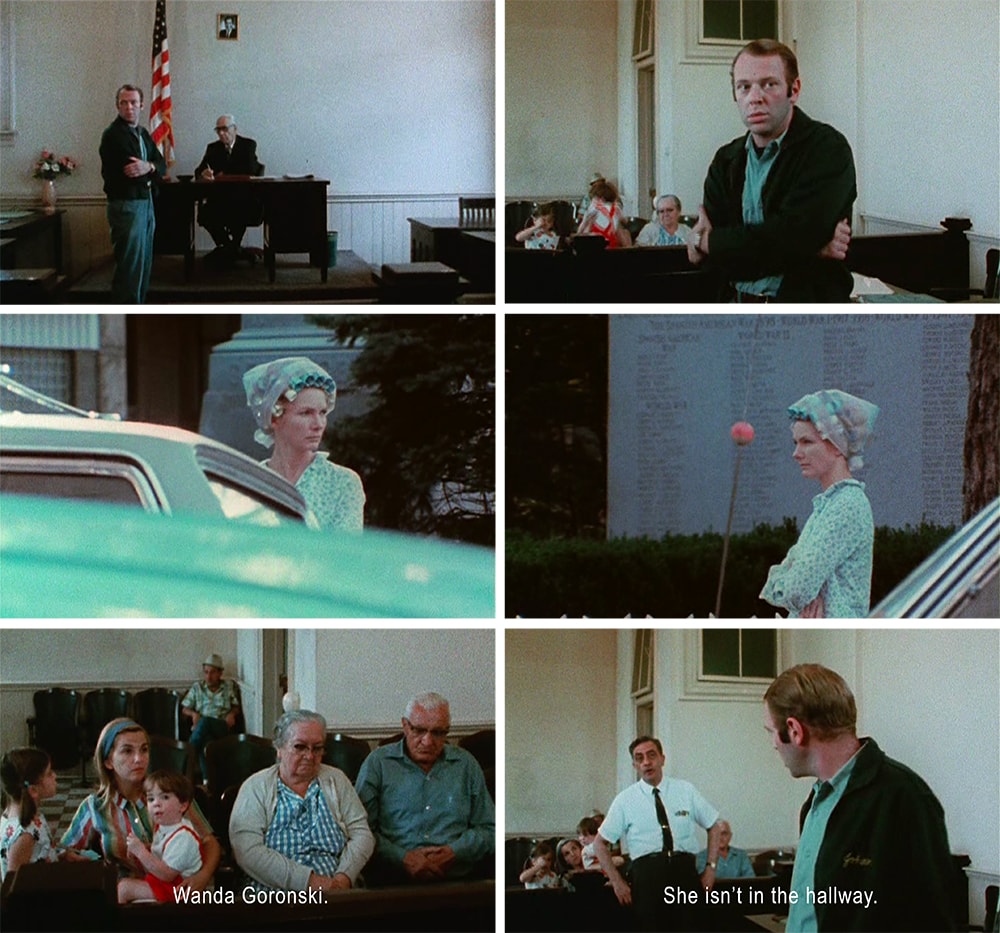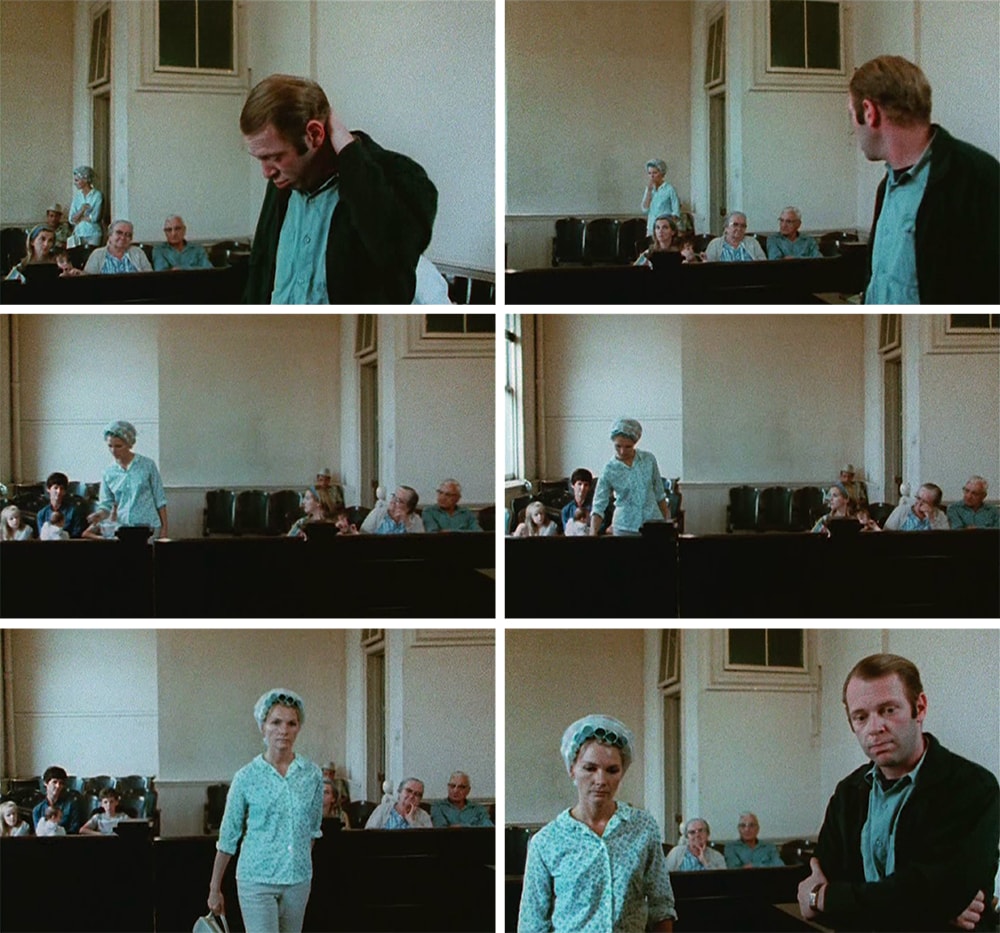Wanda...
Wanda...1 Are we here speaking of the protagonist, who does not speak (or barely), who does not look (except at the floor), who does not present herself (except to herself)? Are we speaking of the film, and of how it shows a character of whom one can say these things? Or are we speaking of the way Wanda was made: for example, how do we imagine the filming of this low-budget production?2
Despite all the improvised preparations, the map seems to track different roads, the car is in fact too heavily loaded, the lunches too quickly consumed. The hill is not marked on the map and is too steep, and there is no place to be found where you can discreetly relieve yourself. In Wanda, we immediately see a different relationship to time. The classic Hollywood narrative says: I do not want a time that passes in the movie theatre (but time that costs a lot of money). The non-traditional film says: due to limited financial resources, I have to opt for time that does pass, time that takes place in the cinema, for the audience. The most important question every filmmaker has to ask himself, therefore, is: how much, and most of all, what kind of time do I need? The answer determines everything.
As a smoothly operating machine that clearly and efficiently delivers meaning, film is a beautiful, modern ideal. Howard Hawks spoke this way about his Westerns. Still, there are things that are left untouched: longing, for example, is not an efficient and well-oiled machine: human relationships are only neat and clear in theory. Hesitation cannot be deployed, any more than awkwardness can, except when the film is a comedy. Wanda is a grandchild of Buster Keaton, all the more so because we are unable to laugh (the Buster Keaton handicap).

Here too, the best solution – as it was for Howard Hawks – is a practical approach. Just give it a try.3 Barbara Loden filmed every bit as economically as Hawks, her fellow filmmaker did: in a single motion of the camera; a few setups had to make do. The efficiency with which she filmed is astonishing. There is no precious European aestheticising. It is brutal and direct.
Why then, does this film give the impression that it takes its time, is even slow? Why does this film not captivate its audiences? Indeed, there is action, the chase, attack, violent death, so why does the film leave its audiences so bewildered? Like Godard’s A bout de souffle, it is an action film without action.
Like Godard, Loden filmed the action from a blind spot. It is ambiguous about motives and causes, objectives and consequences. In action films, people presume that one knows where the story is leading. Loden leaves it all unexplained. However efficient her filming, something essential is missing on screen: an answer. What is there in its place – nothing. A character that is actually not a character, a story not excitingly told, an environment so fearfully ugly that people look away in dismay, ...
In Wanda, everything remains en suspens, Loden’s shots begin a bit too soon, last a bit too long. The dictatorial “Action!” and “Cut!” of the director – bellowed out with such sadistic authority – is here prefaced by a “maybe”. The frame, too, is here too wide, there too narrow. Each shot unravels at edges. There is no other way to escape the constraint of the film set except to act carefully, as if you know nothing about it.
Loden – also as the protagonist, in front of the camera – plays Wanda with great detachment. Her acting implies the character without being that character. She is emphatic but not emphatic – does not identify herself with the character. There is no “bad mother” pathos. Loden disinterestedly abandons that figure to fall where in may in the very first images. She is not together with the character, but engaged in kneading an image from her, as if it were a technical exercise in an acting school.
Just then; something exceptional happens. As Wanda enters the courtroom (justifiably a frequently cited scene), there is emotion and insight. We still do not see the character, but we very clearly see the figure; the blueprint. It is a drawing without shading, without volume, gaunt and lucid. We suddenly see that this is “it”. This is something the traditional film, acted to the full, can never give the viewer: this staggering “this is it.”

When Wanda enters the courtroom – slow is not the appropriate adjective to describe her manner – she is summoned to extinguish her cigarette. She takes a step to the right in order to deposit the cigarette in an ashtray, then sticks her right hand into the pocket of her pants. The three phases carefully flow into one another, three phases in which the workability of the fundamental outline is put to the test. The interweaving immediately becomes a small, but gripping enunciation, expressed with unyielding, obstinate material. That step off to the right, that cigarette, the dust puffing out of that pocket, the shirt hanging out over the pants, the hair curlers under her scarf – Wanda lets herself be documented: the document is the domain of the recalcitrant subject matter. With Actor’s Studio techniques, Loden and her ‘props’ are played against one another, but the final ensemble is never disclosed. Instead of rich, lavish acting, this is gaunt, concentrated focus on what one might be able to do.
Everyone knows what happens then. You shift into document, or more precisely, the documentary. It is a lovely shift: moving alongside the original storyline (if we can call it that). This can never be the ideal of cinema, however, even when one is aware that any film can momentarily be brought out of focus and become a document itself. We stand alongside Barbara Loden and see how she tries Wanda out. This is something quite different from the payback or settling of accounts that such detachment might signify. Such intentions play no role here. There is no rancour, no preaching. This way, the exercise itself can be part of the character. In one layer, the actress stands far outside and above Wanda. In the next layer, her ‘above-and-beyondness’ becomes Wanda herself. The lesson is the presentation, in an entirely unexpected mise en abime.
In the supplements to the DVD release, Isabelle Huppert states that Wanda is not a frontal character – the self-evident precondition for the classic Hollywood film.4 To that, one can add that Wanda is no official film. Wanda represents no collectivity, is not a social representative whom we can delegate, who imposes order to the multiplicity of voices. Wanda does not stand for mothers, or for modern women, or for victims. There is no representation. Wanda always comes up absent.
In the same interview, Huppert mentions that the acting in Wanda unfolds in an entirely different rhythm than in the classic sound film, which works to the rhythm of the dialogues. One can add that Wanda works to the continuity of the eye. Language is articulation (syllables, words, sentences, paragraphs). The eye is in fact perpetually open, between waking and sleeping. In one continuum, our watching slides like a long, stretched-out panoramic motion from foreground to background, from left to right. Sometimes we see something. Mostly, we watch without focusing.
Wanda looks; but does she see anything? Were the opposite the case, we would find ourselves in an engrossing story where questions call for answers, actions provoke reactions and conclusions are drawn from facts. Nothing of all this takes place here. Not that the world, not even that of Wanda, is without rules. It is just that Loden cannot go into that just now. In the here and now she is concerned with “what”, not “why”.
Just how good Barbara Loden’s Wanda is can be seen here: we have no need whatsoever to ask about the “why”. Apparently, we can do without any explanation, and this leaves us dumbfounded, anxious – to quickly suppress that insight.
- 1Wanda (1970) is the first and only full-length film by actress Barbara Loden (1932-1980). She made her film debut with a small role in Wild River (1960), followed by a major role in Splendor in the Grass (1961). Both by Elia Kazan. She was married to Kazan from 1968 until her premature death in 1980.
- 2Loden spent years getting the financing for Wanda, which was filmed on 16mm blown up to 35mm, which gives this colour film a grainy, cinéma vérité aspect. The film was shot in ten weeks time with a technical team of four people. In the United States, Wanda was released in 1970, in only a single cinema in New York, and quickly disappeared from the playbill. In Europe the film has been highly lauded and has unconditional fans, including Marguerite Duras.
- 3A brief synopsis of Wanda, according to the American 2006 Parlour Pictures DVD publication reads: “An overlooked landmark of 70s American cinema. Barbara Loden's Wanda is a radical revisioning of the road movie genre. Writer-director Loden stars as Wanda, a troubled young woman adrift in modern-day industrial wasteland until she embarks on a crime spree with a small-time crook. Bracingly honest and beautifully shot. Loden’s unique film deserves to be counted among the most formidable debuts in the history of independent cinema.”
- 4In France in 2003, Wanda was re-released to cinemas on the initiative of Isabelle Huppert, who purchased the rights to the film. The first European DVD release, by MK2. has been available since 2004.
For over half a century, Belgian critic Dirk Lauwaert (1944-2013) published essays on film for magazines including Film & Televisie, Kunst & Cultuur, Versus, Andere Sinema and De Witte Raaf. In addition, Lauwaert wrote about fashion, photography, the city and visual art. For Lauwaert, such criticism was never a purely professional affair; it was, first and foremost, a way of documenting how a film or a piece of art personally impacted him as an amateur. Lauwaert’s film criticism is not, as yet, internationally recognised. Lauwaert was an author for whom “watching film and loving film [was] a way to be with the world”. Remaining suspicious of “the power over the concrete, which is indispensable for life,” Lauwaert was someone for whom the act of watching films made up his “whole life.” In this sense, film for Lauwaert turned into the experience of that “essential, sublime distance.” A more extensive English introduction to Lauwaert can be found here. You can find other translations of his texts here.
Originally published in A Prior 15 (2007).
Many thanks to Bart Meuleman and Mari Shields.

